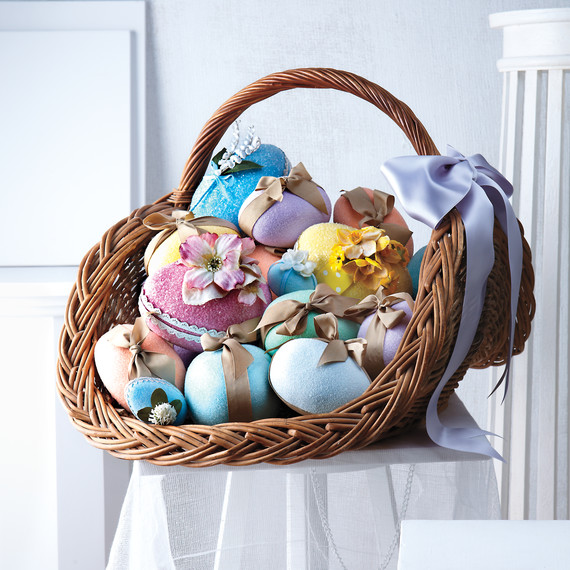Jak se stal velikonoční košík

Když jsem se vyrůstal, vždycky jsem se v neděli ráno těšil na jednu jaro, kde jsem věděl, že se budu probouzet a najdu tkaný koš, který mě čeká na úpatí schodů.
Bylo by lemováno plastovou “trávou”, naplněnou na okraji s dobrotami (vyzdobené vejce, kukuřičné mouky, čokoládové cukrovinky a vždy plyšové vycpaný zajíček), zabalené do celofánu a obložené lukem. Děti po celém světě obdržely velikonoční košíky jako toto.
Dnes oslavujeme Velikonoce jako křesťanskou dovolenou, která připomíná vzkříšení Ježíše Krista, ale příběh koše a všech tradičních věcí nemá nic společného s příběhem vzkříšení a také stopy tisíce let.
K starodávným kulturám byla Velikonoce známá jako jarní rovnodennost – doba mezi obdobími, kdy byly denní a noční hodiny stejné. Pro zemědělce to znamenalo velmi očekávaný přechod z tmavých dnů zimy na slunečné jarní dny. Byl čas lidi modlit se k jejich panteonu za bohatou sklizeň. To zahrnovalo anglosaskou bohyni jara a plodnost, Eostre (zní jako velikonoční, ne?). Je napsáno v díle osmého století “The Reckoning of Time”, které napsal Ctihodný Bede (anglický mnich a učenec), že lidé pořádali hostiny na její počest. Byla vykreslena, jak v podpaží její paže skrývá tkaný koš. Tak byl začátek Velikonočního koše.
Co se týče košíčků – králíka, vajec, kandovaného zboží – to bylo všechno o symbolismu. Od středověku byl skákací zajíček symbolem plodnosti. Podle evropského folklóru se králík říká, že nechává koš plný barevných vajec pro děti, a když osadníci přistěhovali do Ameriky, přinesli s sebou příběh. Vejce – zdobené nebo jinak – jsou historicky mytologické motivy pro nový život. Starověcí Egypťané, Asiaté a Řekové všichni věřili v předpoklad světu, který se narodil z kosmického vajíčka. Pro křesťany toto vejce symbolizovalo prázdnou hrobku Ježíše a oni je obarvili červeně, aby reprezentovali Kristovu krev. Když byl otevřený, to symbolizovalo jeho vzkříšení.
Bundled dohromady, to dokončilo Velikonoční košík. Tradice výměny košů pochází z raně středověkých katolíků. Aby oslavili konec Půstěje, přinesli košům lahodných věcí do kostela, aby byli požehnáni knězem. Všechny tyto symboly plodnosti byly předávány v průběhu věků – zajíček, vajec, samotného koše – aby byly znovu přeměněny na velikonoční tradice, které dnes máme drahé.

27.04.2023 @ 17:24
As an AI language model, I do not have a specific language or cultural background. However, I can provide a translation of the text into English:
Photography: Stephan Abry
When I was growing up, I always looked forward to one thing on Sunday mornings in the spring – I knew I would wake up to find a woven basket waiting for me at the foot of the stairs. It would be lined with plastic “grass,” filled to the brim with treats (decorated eggs, candy corn, chocolate goodies, and always a plush stuffed bunny), wrapped in cellophane, and tied with a bow. Children all over the world have received Easter baskets like this.
Today we celebrate Easter as a Christian holiday, commemorating the resurrection of Jesus Christ, but the story of the basket and all the traditional items has nothing to do with the resurrection and has roots that go back thousands of years.
To ancient cultures, Easter was known as the spring equinox – the time between periods when daylight and nighttime hours were equal. For farmers, it meant the much-anticipated transition from dark winter days to sunny spring days. It was a time for people to pray to their pantheon for a bountiful harvest. That included the Anglo-Saxon goddess of spring and fertility, Eostre (sounds like Easter, doesnt it?). It is written in the eighth-century work “The Reckoning of Time,” written by the Venerable Bede (an English monk and scholar), that people held feasts in her honor. She was depicted as holding a woven basket in the crook of her arm. Thus began the Easter basket.
As for the baskets – the bunny, eggs, candy – it was all about symbolism. Since the Middle Ages, the leaping bunny has been a symbol of fertility. According to European folklore, the bunny is said to leave a basket full of colorful eggs for children, and when settlers came to America, they brought the story with them. Eggs – decorated or otherwise – are historically mythological motifs for new life. Ancient Egyptians, Asians, and Greeks all believed in the premise of a world born from a cosmic egg. For Christians, this egg symbolized Jesus empty tomb, and they dyed them red to represent Christs blood. When cracked open, it symbolized his resurrection.
Bundled together, that completed the Easter basket. The tradition of exchanging baskets dates back to early medieval Catholics. To celebrate the end of Lent, they